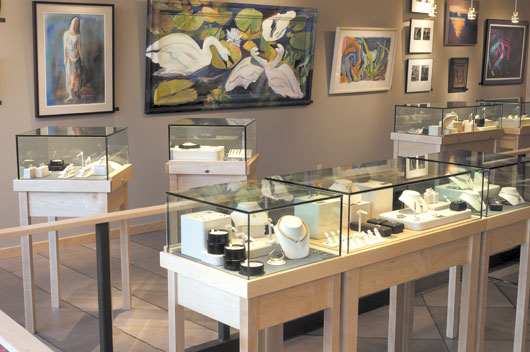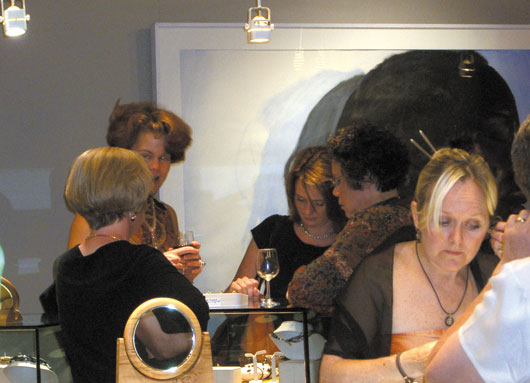Companies who do things right
[h3]T. Lee; Minneapolis, MN[/h3]

[dropcap cap=T]he best jewelry designers create more than just jewelry — they create beautiful, wearable art. So what could be more synergistic for the artistically-minded jewelry designer than a store which features both fine jewelry and fine art?[/dropcap]
[componentheading]THE IDEA[/componentheading]
Bringing the two together was a natural extension given the artistic mindset of designer T. Lee. Lee’s store in Minneapolis’ trendy NeHe (Northeast-Hennepin) area features its own art gallery — and Lee has used it to turn her store into a popular destination for cultural events instead of a mere shopping experience.

Advertisement
[componentheading]THE EXECUTION[/componentheading]
The approach has freed Lee from the burden of trying to dream up new promotional events each year. Now, all she does is announce a new art exhibit every three months — along with a welcome reception for the artist being featured — and the guests come running.
“I wanted a reason to send my clients a postcard regularly without saying ‘buy, buy, buy’ each time,” Lee says. “The cards I send are an introduction to a new fine artist and an invitation to a party — the reception for the artist. It succeeds in putting my name in front of them four times a year without needing to dream up some promotional idea. It’s amazing how after only seven openings, many [customers] ask when the next event is and what kind of work the new artist does.”
Like the plumbing and electrical fixtures, the art gallery was built into the store’s plan early in the build-out phase. The 1,500 square-foot store has a gallery wall that is 35 feet wide and 17 feet high. The wall has a professional artist rails set at 12 feet so painting and photograph exhibits can be easily rotated.
In addition to stocking the display cases with her own jewelry and managing the shop, Lee must also play the role of gallery curator. For years, Lee lived in an artists’ co-op in St. Paul’s “Lowertown”. While living amongst other creative types, Lee networked with a host of artists. Now she does local “art crawls”, making her way through numerous small studios in her search for new talent. Of course, after seven shows, artists are now starting to find her on their own.
Each show consists of limited edition collections by an upcoming artist. Plus, along with each new art collection, Lee displays a new collection of jewelry. Between the new art and the new jewelry, Lee’s customers are encouraged to come back frequently. Says Lee: “I think my clients know the jewelry that debuts at the openings is a small collection of one-of-a-kinds that won’t last long.”
Advertisement

Lee promotes each new exhibit with a postcard campaign. Each features a unique postcard designed with a theme specific to the artist and their exhibition. And since events are scheduled at “regular, predictable intervals, our attendance is always good,” Lee adds.
Postcards usually reach Lee’s client list of 4,000 about one week before the opening reception. (Mailers are also sent to each artist’s mailing list.) To add to the sense of exclusive-ness (and avoid overcrowding), events are not advertised in any local papers.
Lee estimates that running a single exhibition can cost from $3,000 to $6,000. The four events the designer holds annually requires close to three-quarters of her annual promotions budget.
For any retail jewelers looking to try a similar approach, Lee suggests “shopping” for artists at local open studio tours and larger art fairs. Store owners should choose artists carefully as your staff “needs to feel the passion to pass it on and ‘sell’ the work,” Lee says. When testing the waters for such events consider choosing art that has a general appeal to a local market.
One key is finding talented artists who are based locally. This helps keep shipping and other incidental expenses down, and makes it more likely the artist will make an appearance at the opening. (Which also provides the opportunity to sell jewelry to the artist’s clients, friends and family.) “It’s important to my openings that the artist attends them,” Lee says. “No one can pass on the passion for the work like the artists themselves. That builds even deeper commitments to your store.”
Advertisement
[componentheading]THE RESULTS[/componentheading]
Lee says that, so far, every show has been a success. This, even though one exhibitor — a photographer who specialized in nudes — had to have his exhibition displayed in her store’s “annex” (or, as it is more generally referred to, the bathroom). Then there was the time neighboring store owners bristled when Lee brought in a graffiti-on-canvas artist — an event which ended up being Lee’s most lucrative show to date.
[span class=note]This story is from the November 2004 edition of INSTORE[/span]